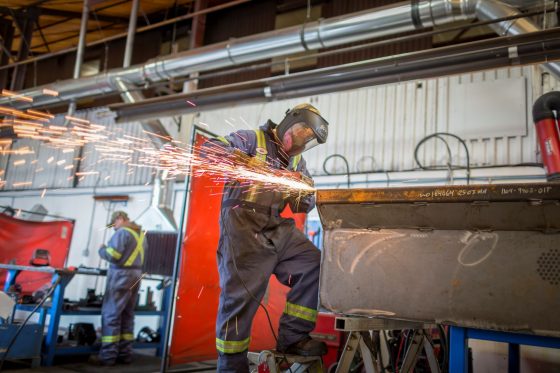A risk of exposure to fire and explosion exists for workers who weld or do other work that generates sparks and can ignite fuel when oxygen is also present.

© WorkSafeBC (Workers’ Compensation Board of B.C.), used with permission
“Hot work” is any task that involves burning, welding, riveting, grinding, or using fire- or spark-producing tools, or other work that produces a source of ignition.
Potentially flammable or explosive substances are present in many industries. Recently I spoke with Monica Feng, a senior engineer at WorkSafeBC who has been reviewing industry practices, codes, standards, and critical controls for preventing fires and explosions — including potentially catastrophic events.
I contacted Monica to learn more about why WorkSafeBC is reaching out to industry about hot work.
“We want to raise employers’ awareness of hot work hazards and provide information on how to prevent this hidden danger from becoming a deadly one,” Monica says. “The danger of flammable vapours is not always obvious but becomes very real when you do what is known as hot work. Many hot work incidents occurred simply because workers didn’t know flammable and explosive vapours were present.”
Employers are reminded to:
- Assess the risks of hot work and identify the potential hazards associated with those work processes.
- Survey the worksite to look for flammable or explosive substances, and potential sources of such substances, that could ignite if exposed to hot work.
- Ensure any new work processes are assessed for potential risks before such processes are implemented.
Undertake gas monitoring before starting any hot work activities
Monica says it’s important to keep in mind what’s known as “the fire triangle”: oxygen, fuel, and an ignition source.
She adds that fuel comes in various forms. Liquid fuels like gasoline are kept in storage tanks and containers. Flammable gases like methane are generated in composting facilities and on dairy farms. Pulp and paper mills generate non-condensable gases, such as hydrogen sulfide, that also can ignite.
Regardless of the industry, if hot work is done in your workplace, it’s essential to check for the presence of flammable substances before such work begins.
Checking for gases requires a properly calibrated combustible gas detector and someone who knows how to use it. If your workers are working on or near storage tanks and other containers, you’ll need to monitor not only those tanks and containers but all other surrounding tanks and adjacent spaces.
For much more information on what to do, see WorkSafeBC’s page Helping to reduce the risk of workplace fires and explosions ignited by hot work.
Thank you to Monica for speaking with me and answering all my questions.


